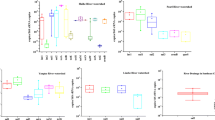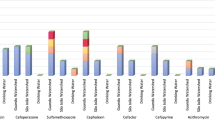Abstract
Antibiotic resistance (AR) is extensively present in various environments, posing emerging threat to public and environmental health. Landfill receives unused and unwanted antibiotics through household waste and AR within waste (e.g., activated sludge and illegal clinical waste) and is supposed to serve as an important AR reservoir. In this study, we used culture-dependent methods and quantitative molecular techniques to detect and quantify antibiotic-resistant bacteria (ARB) and antibiotic resistance genes (ARGs) in 12 landfill leachate samples from six geographic different landfills, China. Five tested ARGs (tetO, tetW, bla TEM, sulI, and sulII) and seven kinds of antibiotic-resistant heterotrophic ARB were extensively detected in all samples, demonstrating their occurrence in landfill. The detected high ratio (10−2 to 10−5) of ARGs to 16S ribosomal RNA (rRNA) gene copies implied that ARGs are prevalent in landfill. Correlation analysis showed that ARGs (tetO, tetW, sulI, and sulII) significantly correlated to ambient bacterial 16S rRNA gene copies, suggesting that the abundance of bacteria in landfill leachate may play an important role in the horizontal spread of ARGs.


Similar content being viewed by others
References
APHA (1998) Standard methods for the evaluation of water and wastewater. American Public Health Association Publishing, Washington
Barlaz MA (1997) Microbial studies of landfills and anaerobic refuse decomposition. Man Environ Microbiol 541–557
Barlaz MA, Schaefer DM, Ham RK (1989) Bacterial population development and chemical characteristics of refuse decomposition in a simulated sanitary landfill. Appl Environ Microbiol 55:55–65
Bound JP, Voulvoulis N (2005) Household disposal of pharmaceuticals as a pathway for aquatic contamination in the United Kingdom. Environ Health Perspect 1705–1711
Chen H, Zhang M (2013) Occurrence and removal of antibiotic resistance genes in municipal wastewater and rural domestic sewage treatment systems in eastern China. Environ Int 55:9–14
China SEPAo (2002) Monitoring and analysis method of water and waste water. China Environmental Science Press, Beijing
Courvalin P (1994) Transfer of antibiotic resistance genes between gram-positive and gram-negative bacteria. Antimicrob Agents Chemother 38:1447
Garcia-Armisen T, Vercammen K, Passerat J, Triest D, Servais P, Cornelis P (2011) Antimicrobial resistance of heterotrophic bacteria in sewage-contaminated rivers. Water Res 45:788–796
Graham DW, Olivares-Rieumont S, Knapp CW, Lima L, Werner D, Bowen E (2010) Antibiotic resistance gene abundances associated with waste discharges to the Almendares River near Havana, Cuba. Environ Sci Technol 45:418–424
Hammer Ø, Harper D, Ryan P (2001) PAST: paleontological statistics software package for education and data analysis. Palaeontolia Electron 4
Huang Z (2014) Study of migration, transformation and removal of antibiotic residues and antibiotic resistance genes in the process of municipal solid waste transfer and landfilling. East China Normal University
Institute of Clinical and Laboratory Standards (2006) Performance standards for antimicrobial disk susceptibility tests. 9th ed. Approved standard M2-A9, Clinical and Laboratory Standards Institute, Wayne, PA
Kim S, Aga DS (2007) Potential ecological and human health impacts of antibiotics and antibiotic-resistant bacteria from wastewater treatment plants. J Toxicol Env Heal B 10:559–573
Kjeldsen P, Barlaz MA, Rooker AP, Baun A, Ledin A, Christensen TH (2002) Present and long-term composition of MSW landfill leachate: a review. Crit Rev Environ Sci Technol 32:297–336
Knapp CW, Dolfing J, Ehlert PA, Graham DW (2009) Evidence of increasing antibiotic resistance gene abundances in archived soils since 1940. Environ Sci Technol 44:580–587
Kotchen M, Kallaos J, Wheeler K, Wong C, Zahller M (2009) Pharmaceuticals in wastewater: behavior, preferences, and willingness to pay for a disposal program. J Environ Manag 90:1476–1482
Kümmerer K (2003) Significance of antibiotics in the environment. J Antimicrob Chemother 52:5–7
Lachmayr KL, Kerkhof LJ, DiRienzo AG, Cavanaugh CM, Ford TE (2009) Quantifying nonspecific TEM β-lactamase (blaTEM) genes in a wastewater stream. Appl Environ Microbiol 75:203–211
Liu L, Liu YH, Wang Z, Liu CX, Huang X, Zhu GF (2014) Behavior of tetracycline and sulfamethazine with corresponding resistance genes from swine wastewater in pilot-scale constructed wetlands. J Hazard Mater 278:304–310
Livermore DM (1995) Beta-lactamases in laboratory and clinical resistance. Clin Microbiol Rev 8:557–584
Luo Y, Mao D, Rysz M, Zhou Q, Zhang H, Xu LJJ, Alvarez P (2010) Trends in antibiotic resistance genes occurrence in the Haihe River, China. Environ Sci Technol 44:7220–7225
Mackie RI, Koike S, Krapac I, Chee-Sanford J, Maxwell S, Aminov RI (2006) Tetracycline residues and tetracycline resistance genes in groundwater impacted by swine production facilities. Anim Biotechnol 17:157–176
Marchesi JR, Sato T, Weightman AJ, Martin TA, Fry JC, Hiom SJ, Wade WG (1998) Design and evaluation of useful bacterium-specific PCR primers that amplify genes coding for bacterial 16S rRNA. Appl Environ Microbiol 64:795–799
Martinez JL (2009) Environmental pollution by antibiotics and by antibiotic resistance determinants. Environ Pollut 157:2893–2902
Mazel D (2004) Integrons and the origin of antibiotic resistance gene cassettes-super integrons with thousands of gene cassettes may have set the stage for pathogens to develop antibiotic resistance very rapidly. ASM News-Am Soc Microbiol 70:520–525
Metzger J (2004) Drugs in municipal landfills and landfill leachates, Pharmaceuticals in the environment. Springer pp 133–137
Michigan Department of Environmental Quality (2007) A remedy for residential drug disposal, Michigan Department of Environmental Quality, Lansing, Michigan
Munir M, Wong K, Xagoraraki I (2011) Release of antibiotic resistant bacteria and genes in the effluent and biosolids of five wastewater utilities in Michigan. Water Res 45:681–693
Musson SE, Townsend TG (2009) Pharmaceutical compound content of municipal solid waste. J Hazard Mater 162:730–735
Office of National Drug Control Policy (2007) Proper disposal of prescription drugs, executive office of the president of the United States. Office of National Drug Control Policy, Washington
Peak N, Knapp CW, Yang RK, Hanfelt MM, Smith MS, Aga DS, Graham DW (2007) Abundance of six tetracycline resistance genes in wastewater lagoons at cattle feedlots with different antibiotic use strategies. Environ Microbiol 9:143–151
Pei R, Kim S-C, Carlson KH, Pruden A (2006) Effect of river landscape on the sediment concentrations of antibiotics and corresponding antibiotic resistance genes (ARG). Water Res 40:2427–2435
Pruden A, Pei R, Storteboom H, Carlson KH (2006) Antibiotic resistance genes as emerging contaminants: studies in northern Colorado. Environ Sci Technol 40:7445–7450
Sarmah AK, Meyer MT, Boxall ABA (2006) A global perspective on the use, sales, exposure pathways, occurrence, fate and effects of veterinary antibiotics (VAs) in the environment. Chemosphere 65:725–759
Schmitt H, Stoob K, Hamscher G, Smit E, Seinen W (2006) Tetracyclines and tetracycline resistance in agricultural soils: microcosm and field studies. Microb Ecol 51:267–276
Scott KP, Melville CM, Barbosa TM, Flint HJ (2000) Occurrence of the new tetracycline resistance gene tet (W) in bacteria from the human gut. Antimicrob Agents Chemother 44:775–777
Sköld O (2000) Sulfonamide resistance: mechanisms and trends. Drug Resist Updat 3:155–160
Song LY, Zhao YC, Sun WM, Lou ZY (2009) Hydrophobic organic chemicals (HOCs) removal from biologically treated landfill leachate by powder-activated carbon (PAC), granular-activated carbon (GAC) and biomimetic fat cell (BFC). J Hazard Mater 163:1084–1089
Threedeach S, Chiemchaisri W, Watanabe T, Chiemchaisri C, Honda R, Yamamoto K (2012) Antibiotic resistance of Escherichia coli in leachates from municipal solid waste landfills: comparison between semi-aerobic and anaerobic operations. Bioresour Technol 113:253–258
Wu P, Shannon K, Phillips I (1994) Effect of hyperproduction of TEM-1 beta-lactamase on in vitro susceptibility of Escherichia coli to beta-lactam antibiotics. Antimicrob Agents Chemother 38:494–498
Wu N, Qiao M, Zhang B, Cheng W-D, Zhu Y-G (2010) Abundance and diversity of tetracycline resistance genes in soils adjacent to representative swine feedlots in China. Environ Sci Technol 44:6933–6939
Xi C, Zhang Y, Marrs CF, Ye W, Simon C, Foxman B, Nriagu J (2009) Prevalence of antibiotic resistance in drinking water treatment and distribution systems. Appl Environ Microbiol 75:5714–5718
Zhang Y, Marrs CF, Simon C, Xi C (2009) Wastewater treatment contributes to selective increase of antibiotic resistance among Acinetobacter spp. Sci Total Environ 407:3702–3706
Zhu Y-G, Johnson TA, Su J-Q, Qiao M, Guo G-X, Stedtfeld RD, Hashsham SA, Tiedje JM (2013) Diverse and abundant antibiotic resistance genes in Chinese swine farms. Proc Natl Acad Sci 110:3435–3440
Acknowledgments
The authors acknowledge the Chinese Academy of Science, China, for financial support for the research with Contract No KZCX2-XB3-14. We would like to thank the anonymous reviewers for offering valuable suggestions that greatly improved the manuscript.
Author information
Authors and Affiliations
Corresponding author
Additional information
Responsible editor: Leif Kronberg
Electronic supplementary material
Below is the link to the electronic supplementary material.
ESM 1
(DOCX 382 kb)
Rights and permissions
About this article
Cite this article
Wang, Y., Tang, W., Qiao, J. et al. Occurrence and prevalence of antibiotic resistance in landfill leachate. Environ Sci Pollut Res 22, 12525–12533 (2015). https://doi.org/10.1007/s11356-015-4514-7
Received:
Accepted:
Published:
Issue Date:
DOI: https://doi.org/10.1007/s11356-015-4514-7




